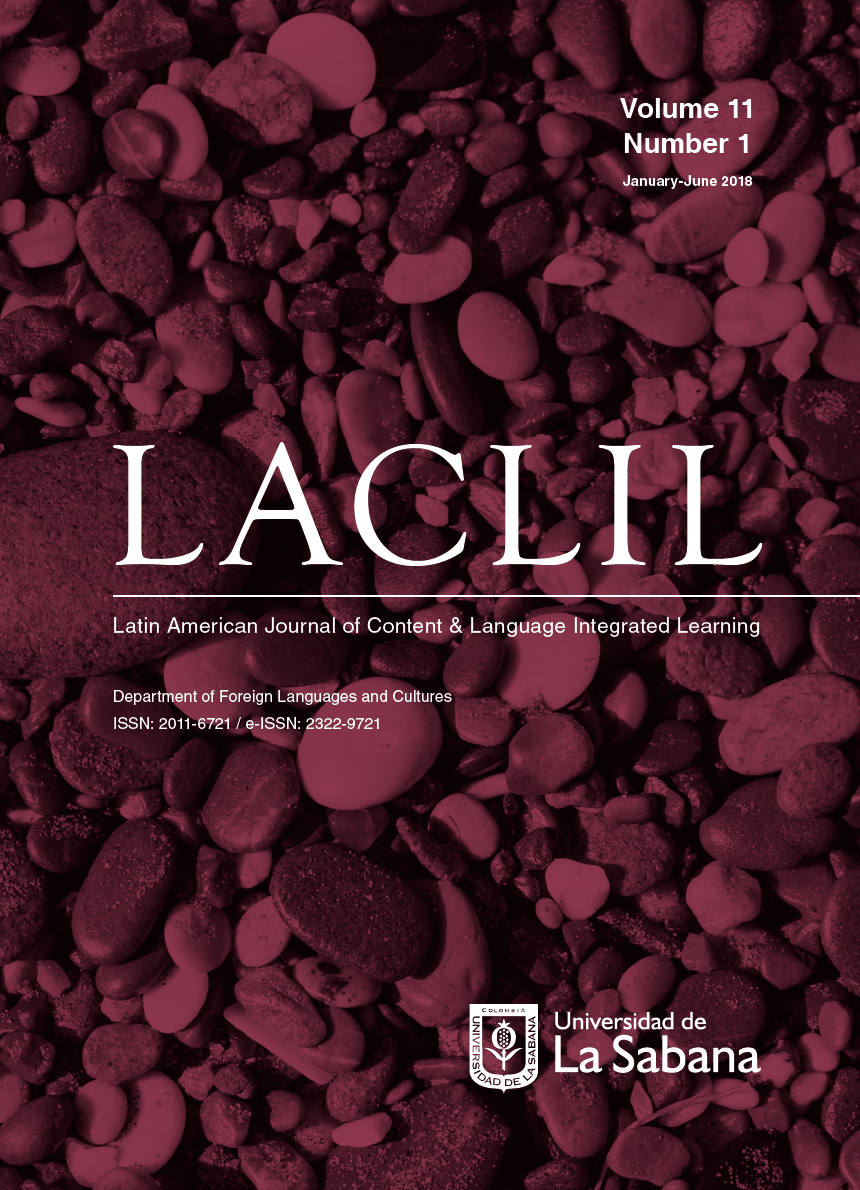CLIL across the Curriculum, benefits that go beyond the classroom
Keywords:
CLIL, Curriculum, CBI, Content Based Curriculum, HOTS, LOTS, CALP, BICSDownloads
References
Alcaraz-Mármol, G. (2018). Trained and non-trained language teachers on CLIL methodology: teachers’ facts and opinions about the CLIL approach in the primary education context in Spain. Latin American Journal of Content & Language Integrated Learning, 11(1), 39-64. doi: 10.5294/laclil.2018.11.1.3
Anderson, C. E. (2011). CLIL for CALP in the multilingual, pluricultural, globalized knowledge society: Experiences and backgrounds to L2 English usage among Latin American L1 Spanish-users. Latin American Journal of Content and Language Integrated Learning, 4(2), 51–66. doi: 10.5294/laclil.2011.4.2.5
Argudo, J., Abad, M., Fajardo-Dack, T., & Cabrera, P. (2018). Analyzing a pre-service EFL program through the lenses of the CLIL (Content and Language Integrated Learning) approach at Universidad de Cuenca, Ecuador. Latin American Journal of Content & Language Integrated Learning, 11(1), 65-86. doi: 10.5294/laclil.2018.11.1.4
Bellés-Calvera, L. (2018). Teaching Music in English: A Content-Based Instruction Model in Secondary Education. Latin American Journal of Content & Language Integrated Learning, 11(1), 109-139. doi: 10.5294/ laclil.2018.11.1.6
Cenoz, J. (2015). Content-based instruction and content and language integrated learning: the same or different? Language, Culture and Curriculum. doi: 10.1080/07908318.2014.1000922
Coyle, D., Hood, P., & Marsh, D. (2010). CLIL. Cambridge: Cambridge University Press.
Cummins, J. (1989). Theoretical Background. TESOL Quarterly Article Stable URL. doi: 10.1007/978-3-642-27526-5_2
Cummins, J. (2000). Language Proficiency in Academic Contexts Evolution of the Conversational/Academic Language Proficiency Distinction. In Language, Power, and Pedagogy.
Deyrich, M.-C., & Stunnel, K. (2014). Language education models: New issues and challenges. In English as a foreign language teacher education: Current perspectives and challenges (p. 364).
Görlach, M. (1999). David Graddol, The Future of English? A Guide to Forecasting the Popularity of the English Language in the 21st Century I>. English World-Wide. 10.1075/eww.20.1.11gor
Graham, K. M., Choi, Y., Davoodi, A., Shakiba, R., & Dixon, L. Q. (2018). Language and content outcomes of CLIL and EMI: a systematic review. Latin American Journal of Content & Language Integrated Learning, 11(1), 19-37. doi: 10.5294/laclil.2018.11.1.2
Granados, J. (2018). The Challenges of Higher Education in the 21st Century. Retrieved September 1, 2018, from http://www.guninetwork.org/ articles/challenges-higher-education-21st-century
Halbach, A. (2012). Questions about basic interpersonal communication skills and cognitive language proficiency. Applied Linguistics. doi: 10.1093/applin/ams058
Jarson, J. (2010). Information literacy and higher education: A toolkit for curricular integration. College & Research Libraries News, 71(10), 534–538.
Khatib, M., & Taie, M. (2016). BICS and CALP: Implications for SLA. Journal of Language Teaching and Research, 7(2), 382. doi: 10.17507/jltr.0702.19
Meyer, O., Coyle, D., Halbach, A., Schuck, K., & Ting, T. (2015). A pluriliteracies approach to content and language integrated learning- Mapping learner progressions in knowledge construction and meaning-making. Language, Culture and Curriculum, 28(1). doi: 10.1080/07908318.2014.1000924
Pinner, R. (2013). Authenticity and CLIL: Examining Authenticity from an International CLIL Perspective. International CLIL Research Journal.
Popović, D. (2014). Guest editor´s introduction: The challenges students are facing in the 21st century. Singidunum Journal of Applied Linguistics, 11(1), 1–4.
Reitbauer, M., Fürstenberg, U., Kletzenbauer, P., & Marko, K. (2018). Towards a cognitive-linguistic turn in CLIL: unfolding integration. Latin American Journal of Content & Language Integrated Learning, 11(1), 87-107. doi: 10.5294/laclil.2018.11.1.5
Robinson, K. (2001). Mind the gap: The creative conundrum. Critical Quarterly, 43(1), 41–45. doi: 10.1111/1467-8705.00335
Robinson, K. (2011). Out of our minds: Learning to be creative (2nd ed.). Chichester, UK: Capstone/John Wiley & Sons. Retrieved from http://www. amazon.com/Out-Our-Minds-Learning-Creative-ebook/dp/B005CKKETU/
Robinson, K., & Aronica, L. (2009). The element: How finding your passion changes everything. London, UK: Allen Lane.
Robinson, K., Minkin, L., & Bolton, E. (1999). All Our Futures : Creativity , Culture and Education. National Advisory Committee on Creative and Cultural Education. doi: 10.1075/prag.22.3.02gre
Sarasa, M. C., & Porta, L. G. (2018). Narratives of desire, love, imagination, and fluidity: becoming an English teacher in a university preparation program. Latin American Journal of Content & Language Integrated Learning, 11(11), 141-163. doi: 10.5294/laclil.2018.11.1.7
UNESCO. (2018). Internacional Bureau of Education. Available from http:// www.ibe.unesco.org/en/ibe-alert/12-july-2018
Várkuti, A. (2010). Linguistic Benefits of the CLIL Approach: Measuring Linguistic Competences. International CLIL Research Journal, 1(3), 67-79. Available from http://www.icrj.eu/13/article7.html
Vázquez, V. P., & Gaustad, M. (2013). Designing Bilingual Programmes for Higher Education in Spain : Organisational , Curricular and Methodological Decisions, 2(1), 82–94.
Published
How to Cite
Issue
Section
License
This Journal and its articles are published under the Creative Commons CC BY 4.0 DEED Attribution 4.0 International license. You are free to: Share — copy and redistribute the material in any medium or format for any purpose, even commercially. Adapt — remix, transform, and build upon the material for any purpose, even commercially. The license cannot revoke these freedoms as long as you follow the terms of the license.




